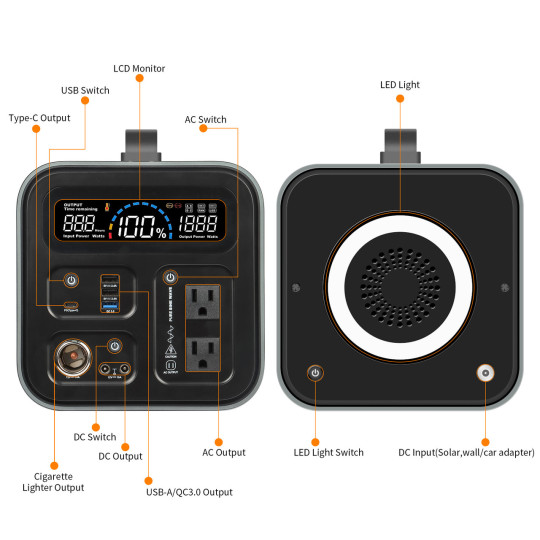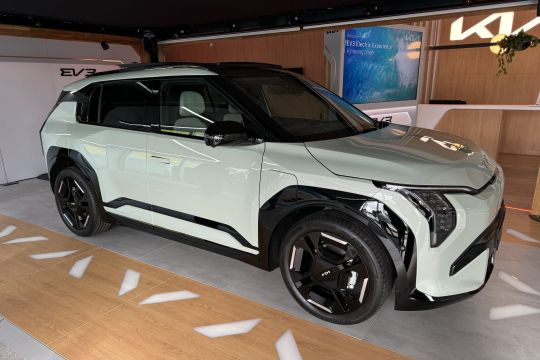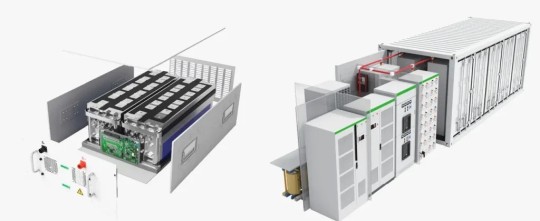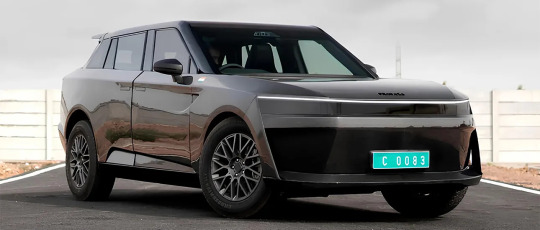#DC Lithium Battery
Explore tagged Tumblr posts
Text
How to Calculate the Right Battery Size for Your Caravan or 4WD
To properly size a battery for your caravan or 4WD, calculate the total energy consumption of all devices you plan to run, considering their wattage and hours of usage. Use this information to determine the required amp-hour (Ah) capacity. Take into account factors like battery type and usage conditions to ensure your system meets your power needs. The right battery size ensures reliable power without overloading the system or compromising performance.
0 notes
Text
Tata Curvv EV Review: Cutting-Edge Tech and Safety Features
₹18.49Lakh General Overview Design and Exterior Styling Type: Coupe, a segment that blends sporty looks with practicality, offering an eye-catching profile alongside functional design elements. Colors: The Curvv EV is available in a palette of bold and elegant colors including Virtual Sunrise, Pure Grey, Flame Red, and Pristine White. The dual-tone finish with a contrast roof adds a touch of…
#10.25-inch Cinematic Touchscreen Infotainment system#110 kW motor#147.51 bhp#186 mm ground clearance#215 Nm torque#45 kWh lithium-ion battery#5-seater cabin#502 km range#6 Airbags#8-year battery warranty#AC charging (7.2 kW): 6.5 hours#acceleration: 0 to 100 km/h in 9 seconds#ADAS: ABS#advanced technology#aerodynamic efficiency#Air Purifier#Android Auto#Apple CarPlay#automatic climate control#Brake Assist#CCS 2 charging standard#central armrest#Connected Car Technology#coupe styling#DC Fast Charging (60 kW): 80% in 40 minutes#dimensions: 4310 mm length#disc brakes#EBD#electric steering system#electric vehicle (EV)
0 notes
Text
GOFORT Portable Power Station, 550Wh Solar Generator With 600W (Peak 1200W) 110V AC Outlets, 120W 12V DC, QC3.0&TypeC, SOS Flashlight, Backup Power Lithium Battery Pack For Outdoor RV/Van Camping CPAP



#GOFORT Portable Power Station#550Wh Solar Generator With 600W (Peak 1200W) 110V AC Outlets#120W 12V DC#QC3.0&TypeC#SOS Flashlight#Backup Power Lithium Battery Pack For Outdoor RV/Van Camping CPAP
0 notes
Text
the Official Samsung charger brick is always quiet enough* until my phone reaches 100 and then it starts shrieking*. what is up with that
*autistic
0 notes
Text
Things Biden and the Democrats did, this week #9
March 9-15 2024
The IRS launched its direct file pilot program. Tax payers in 12 states, Florida, New Hampshire, Nevada, South Dakota, Tennessee, Texas, Washington, Wyoming, Arizona, Massachusetts, California and New York, can now file their federal income taxes for free on-line directly with the IRS. The IRS plans on taking direct file nation wide for next year's tax season. Tax Day is April 15th so if you're in one of those states you have a month to check it out.
The Department of Education’s Office of Civil Rights opened an investigation into the death of Nex Benedict. the OCR is investigating if Benedict's school district violated his civil rights by failing to protect him from bullying. President Biden expressed support for trans and non-binary youth in the aftermath of the ruling that Benedict's death was a suicide and encouraged people to seek help in crisis
Vice President Kamala Harris became the first sitting Vice-President (or President) to visit an abortion provider. Harris' historic visit was to a Planned Parenthood clinic in St. Paul Minnesota. This is the last stop on the Vice-President's Reproductive Rights Tour that has taken her across the country highlighting the need for reproductive health care.
President Biden announced 3.3 billion dollars worth of infrastructure projects across 40 states designed to reconnect communities divided by transportation infrastructure. Communities often split decades ago by highways build in the 1960s and 70s. These splits very often affect communities of color splitting them off from the wider cities and making daily life far more difficult. These reconnection projects will help remedy decades of economic racism.
The Biden-Harris administration is taking steps to eliminate junk fees for college students. These are hidden fees students pay to get loans or special fees banks charged to students with bank accounts. Also the administration plans to eliminate automatic billing for textbooks and ban schools from pocketing leftover money on student's meal plans.
The Department of Interior announced $120 million in investments to help boost Climate Resilience in Tribal Communities. The money will support 146 projects effecting over 100 tribes. This comes on top of $440 million already spent on tribal climate resilience by the administration so far
The Department of Energy announced $750 million dollars in investment in clean hydrogen power. This will go to 52 projects across 24 states. As part of the administration's climate goals the DoE plans to bring low to zero carbon hydrogen production to 10 million metric tons by 2030, and the cost of hydrogen to $1 per kilogram of hydrogen produced by 2031.
The Department of Energy has offered a 2.3 billion dollar loan to build a lithium processing plant in Nevada. Lithium is the key component in rechargeable batteries used it electric vehicles. Currently 95% of the world's lithium comes from just 4 countries, Australia, Chile, China and Argentina. Only about 1% of the US' lithium needs are met by domestic production. When completed the processing plant in Thacker Pass Nevada will produce enough lithium for 800,000 electric vehicle batteries a year.
The Department of Transportation is making available $1.2 billion in funds to reduce decrease pollution in transportation. Available in all 50 states, DC and Puerto Rico the funds will support projects by transportation authorities to lower their carbon emissions.
The Geothermal Energy Optimization Act was introduced in the US Senate. If passed the act will streamline the permitting process and help expand geothermal projects on public lands. This totally green energy currently accounts for just 0.4% of the US' engird usage but the Department of Energy estimates the potential geothermal energy supply is large enough to power the entire U.S. five times over.
The Justice for Breonna Taylor Act was introduced in the Senate banning No Knock Warrants nationwide
A bill was introduced in the House requiring the US Postal Service to cover the costs of any laid fees on bills the USPS failed to deliver on time
The Senate Confirmed 3 more Biden nominees to be life time federal Judges, Jasmine Yoon the first Asian-America federal judge in Virginia, Sunil Harjani in Illinois, and Melissa DuBose the first LGBTQ and first person of color to serve as a federal judge in Rhode Island. This brings the total number of Biden judges to 185
#Thanks Biden#Joe Biden#Democrats#politics#US politics#good news#nex benedict#abortion#taxes#climate change#climate action#tribal communities#lithium#electronic cars#trans rights#trans solidarity#judges
366 notes
·
View notes
Text
Dandelion News - August 22-28
Like these weekly compilations? Tip me at $kaybarr1735 or check out my new(ly repurposed) Patreon!
1. Safari park welcomes flamingo chicks

“An animal park has said it is experiencing a "baby boom", including new flamingo chicks that have hatched. Longleat Safari Park in Wiltshire has also recently welcomed rare Amur tiger cubs and an endangered cotton top tamarin monkey baby. [… Flamingos] live 15-20 years in the wild, however in captivity and safe from predators, they can reach ages of 70 years.”
2. Golf clubs fight biodiversity loss

“The project aims to help green-keepers create havens for wildlife, particularly bees and butterflies, as well as introduce mowing methods to protect rare chalk grassland and encourage wildflowers. […] “Clubs doing this are seeing significant increases in pollinators, such as butterflies, without impeding the game."”
3. ‘We’ve got baby owls again’: how farming policy is helping English wildlife

“[In Abby Allen’s] lush Devon fields native cattle graze alongside 400-year-old hedgerows, with birds and butterflies enjoying the species-rich pasture. [… The Environmental Land Management Scheme] pays farmers for things such as planting hedges, sowing wildflowers for birds to feed on and leaving corners of their land wild for nature.”
4. $440 Million to Support Pregnant and New Moms, Infants, and Children through Voluntary Home Visiting Programs
“Through this program […] trained health workers […] provide support on breastfeeding, safe sleep for babies, learning and communications practices that promote early language development, developmental screening, getting children ready to succeed in school, and connecting with key services and resources in the community – like affordable childcare or job and educational opportunities. […] In addition, the [CDC] announced a new investment of $118.5 million, over five years, to 46 states [and] six territories […] to continue building the public health infrastructure to better identify and prevent pregnancy-related deaths.”
5. Endangered leopard frogs released into the wild

“More than a hundred leopard frogs have been released into the wild at Columbia National Wildlife Refuge in Washington state. Leopard frogs are endemic to North America but have been classed as endangered since 1999.”
6. Heat-based batteries are a surprisingly versatile tool

“[T]hermal energy storage [… is] expected to be more cost-effective than conventional lithium-ion batteries for storing cheap clean electricity over longer durations[….] Thermal storage systems take up less space per unit of energy stored than lithium-ion batteries do, [… and] can also deliver their stored energy without the efficiency losses that occur in converting electricity from [AC to DC and back].”
7. Dolly Parton is sending free books to children across 21 states — and around the world

“[In 21 states,] all children under the age of 5 can enroll to have books mailed to their homes monthly. […] Since the program started, books have been sent to more than 240 million to [sic] kids in the U.S., Canada, the United Kingdom, Ireland and Australia.”
8. Biden-Harris Administration Awards $100 Million to Navigators Who Will Help Millions of Americans - Especially in Underserved Communities - Sign Up for Health Coverage
“The grants are part of a commitment of up to $500 million over five years - the longest grant period and financial commitment to date, and a critical boost for recruiting trusted local organizations to better connect with those who often face barriers to obtaining health care coverage. […] Navigators offer free assistance to people exploring health coverage options through HealthCare.gov, from reviewing available plans to assisting with eligibility and enrollment forms, and post-enrollment services such as using their coverage to get care.”
9. ‘Ultra-Accommodating’ Hotel Concept Goes Beyond ADA Accessible

“The property […] will feature wider hallways, larger guest rooms, easy access to elevators and other modifications that exceed the standards required under the [ADA]. Staff will be trained in disability etiquette, how to assist with mobility devices and provide various accommodations ranging from hearing aid loops to sensory-sensitive lighting. […] The location in San Antonio is expected to be the first — not the only one — developed under this concept.”
10. Melbourne zoo welcomes rare southern white rhino calf to the world

“Kipenzi and the new calf have been closely monitored this week, with mother and baby being kept in a secluded area accessible only to keepers while they get to know each other and bond. […] The calf has already been showing a forthright personality, snorting and stomping around his enclosure[….]”
August 15-21 news here | (all credit for images and written material can be found at the source linked; I don’t claim credit for anything but curating.)
#hopepunk#good news#flamingo#zoo#animals#tiger#monkey#golf#golf course#biodiversity#farming#farm#england#uk#pregnancy#education#reproductive health#healthcare#frogs#endangered species#washington state#energy storage#batteries#electricity#dolly parton#books#health insurance#accessibility#white rhino#rhino
28 notes
·
View notes
Note
I want to lower my expectations for Tommy being next episode.
But I’m so curious about how they will land the plane. I saw the promo, when the plane going down, and Athena's hand seems not on the control stick, so I think this scene is not landing, maybe something happened to the plane, so the plane looks like going down suddenly (bcuz if that scene is landing, that ankle, not logic). Also I saw the plane explode and no passengers in the seats, I could think they had landed but the plane for some reason would explode. The man looks like trying to see who hasn’t left the plane and evacuate them safely, this job usually is done by the captain when in emergencies. I’m not an aviation expert😭 Just a fan of ACI. Damn I’m so curious
Oh, I love that show.
Very good, top of the class, that is not the angle you want for a landing. You should be slowing down and gently touching the ground instead of entering a high speed nose dive. Looking at the promo, I think something is going very wrong with the plane? You can see in one shot the cabin goes dark, you have people screaming and sparks flying everywhere. Maybe that's why they can't make it to the airport? And have to land on the nearest highway instead?


We don't know for sure the extent of the damage caused by the collision and the subsequent debris, so a lot of things can suddenly go wrong: engine fire/failure, lithium battery explosion, electrical fires etc.

The year after the brand spanking new Boeing 787 entered service, lithium batteries on board 2 different aircrafts suddenly caught on fire, leading to a brief grounding of the type. IMO that's the beginning of Boeing's recent downfall.
A lot of things can go wrong after touchdown, during the rollout as well. I don't know if you've watched or remember the Southern Airways Flight 242 episode, the DC-9 suffered dual engine failure due to water and hail ingestion and it was forced to land on a rural highway. The landing itself was a bit bumpy, but otherwise successful, it was during the rollout that its left wing hit a gas station, triggering an explosion and throwing it sharply to the left, causing it to ultimately crash into a woodland area. That highway with Bobby and the 119 truck on it seems wider and relatively free of obstacle, but the plane can still hit something. The landing can be a bit unstable and one of the engines scrap the road, igniting jet fuel? Or it can be simply smoking hot brakes setting some leaking fuel on fire.
As for Tommy's presence in the episode, the writers can always pull the off duty card if they don't want him there. But if he is on duty, well, you see the 217 truck there, so he should be there. If they can fit Tommy in a short scene in 8x01 to establish his presence in Buck and Eddie's private life, they can make him part of the rescue effort to demonstrate his connection to Buck and the 118's professional life as well. He can also be in a helicopter, flying injured people to the hospital, but if that's the case, don't expect to see him doing it. I seriously doubt the show would spend that much money to rent a helicopter mockup for one short scene that doesn't contribute to the major plot. We might get luck and see him getting in/out of the chopper, but it'll probably be merely a mention.
I miss him, I hope to see his face on Friday, so I'm praying he's working on the ground this time.
7 notes
·
View notes
Text





Kia EV3 Electric Car Lease
But how will the new EV3 perform - is it a good EV? The brand have confirmed two battery derivatives will be available for the UK market including:
EV3 Standard Range - the 55 kWh lithium-ion battery will offer 0 – 62 times of 7.5 seconds, 106 mph top speeds and 150 kW (or 201 hp). This model is a FWD option. Expect a combined winter range of 170 miles with warmer weather allowing for 230 miles - 200 miles combined. On charging, the 11 kW AC max will allow 6 hour 0 – 100% charging times with the 100 kW DC maximum allowing 32 minute 10 – 80% times. This has a cargo volume of 460L and vehicle fuel equivalent of 147 mpg. The EV3 will feature bidirectional charging - a 3.6kW AC Vehicle-to-Load (V2L). An indoor and outdoor port means you can power external devices too; and
EV3 Long Range - the 78 kWh lithium-ion battery will offer 0 – 62 times of 7.7 seconds, 106 mph top speeds and 150 kW (or 201 hp). This model is a FWD option. Expect a combined winter range of 235 miles with warmer weather allowing for 320 miles - 280 miles combined. On charging, the 11 kW AC max will allow 8 hour and 30 min 0 – 100% charging times with the 135kW DC maximum allowing 33 minute 10 – 80% times. This has a cargo volume of 460L and vehicle fuel equivalent of 145 mpg. The EV3 will feature bidirectional charging - a 3.6kW AC Vehicle-to-Load (V2L). An indoor and outdoor port means you can power external devices too.
3 notes
·
View notes
Text
ford Mustang Mach E Price In India & Launch Date: Design, Battery, Features
Ford Mustang Mach E Price In India & Launch Date:Ford is about to launch Mustang Mach E, Ford company has also filed the trademark of Ford Mustang Mach E in India. Know very well about Ford Mustang Mach E Price In India as well as Ford Mustang Mach E Price In India. Talking about performance, we get to see quite powerful performance in this car. Ford Mustang Mach E car is an electric car, the design of the car is very attractive.
Read More
Ford's Comeback In India: Endeavour & Mustang Mach-E ...
Ford Mustang Mach E Price In India (Expected) :If media news reports are to be believed, the ex-showroom price of this car in India could be around Rs 70 Lakh Rupees. Ford is about to launch the Mustang Mach E car. Today people are liking EV cars a lot in the automobile market.
Ford Mustang Mach E Design
The design of Ford Mustang Mach-E electric SUV car is similar to the Mustang sports car. Mustang Mach E is an electric compact crossover SUV, 5 people can sit comfortably in this car. Gives a slightly sporty feel to the car's appearance. In the interior of the electric car, we get to see a large touchscreen infotainment system as well as a digital instrument cluster. Panoramic sunroof, LED headlights, LED tail lights are also seen. A very advanced interior can be seen.
Ford Mustang Mach E Battery & Range
Gives a range of up to 314 km and it takes 10 hours to charge this battery with home charging. We get to see 2 battery variants, one is a standard range battery and the other is an extended range battery. 75.9 kWh lithium-ion battery gets to see.It takes 13 hours to charge through home charger i.e. AC Charging. Talking about extended range battery, in this variant we get an increased battery of 98.8 kWh, a range of 482 kilometers. It takes 60 minutes to charge a standard range battery with a DC charger. It takes 60 minutes to charge with a DC charger.
#detective comics#i just keep seeing more and more posts like that and it’s just. yes it is those things you’re right
but i hate that that’s how we have to get people to care
you shouldn’t have to use sjw buzzwords to get people to care
you should care because there are people dying by the thousands at israel’s hand
free palestine
greatest hits
2 notes
·
View notes
Text
FEATURES:
4.2V/3.6V Battery Charging Module
Can Charge Lithium Ion And Lithium Phosphate Battery
Adjustable Output Current
Recommended Input Voltage: 4.5V – 7V DC
Embedded Switching Regulator
Single Battery Charger Module
Programable Charge Curren Form 0.1A to 2A
Programable Precharge Current Form 10% to 100%
LED Indication
5 notes
·
View notes
Text
Basic understanding of battery energy storage system: battery, PCS, BMS

With the increasingly serious global energy crisis and the increasing awareness of environmental protection, energy storage technology has become one of the important means to solve energy problems.
Battery energy storage systems are currently one of the most common and practical energy storage technologies. In the battery energy storage system, the battery, PCS, and BMS are its most basic components. Let’s take a look at these three basic concepts.
Battery
The battery is the core part of the battery energy storage system. It is a device that converts chemical energy into electrical energy. It consists of four parts: positive electrode, negative electrode, electrolyte and separator. There are many types of batteries, the common ones include lead-acid batteries, nickel-metal hydride batteries, lithium-ion batteries, etc. Among them, lithium-ion batteries have become the most commonly used battery type in current battery energy storage systems due to their high energy density, long life, and environmental protection.
PCS
PCS is the core equipment in the battery energy storage system. It is a device that converts the electric energy stored in the battery into AC electric energy and supplies it to the grid or users. PCS mainly consists of inverters, transformers, controllers, etc. Its main function is to convert DC power into AC power, control the input and output of power, and ensure the safety and stability of the system. The performance of PCS directly affects the operating efficiency and service life of the battery energy storage system.
BMS
BMS is the abbreviation of battery management system and is an important part of the battery energy storage system. BMS is mainly composed of monitoring module, control module, communication module and other parts. Its main function is to monitor and control the status of the battery in real time, including battery voltage, current, temperature, SOC and other parameters. At the same time, BMS can also protect and control the battery, such as overcharge, over-discharge, over-current, etc., to ensure the safety and life of the battery.
To sum up, batteries, PCS, and BMS are the three basic components of battery energy storage systems. As the core part, the battery is responsible for storing energy; PCS converts the electric energy stored in the battery into AC electric energy; BMS monitors and protects the battery in real time to ensure the safety and life of the battery. In the design and operation of battery energy storage systems, the coordination of the three is crucial. Only in this way can the efficient, stable and safe operation of the battery energy storage system be achieved.
2 notes
·
View notes
Text
Pravaig DEFY SUV India: A Comprehensive Review of Design, Price, Range, Features, Specs & More

The Pravaig Defy SUV emerges as a pioneering creation in India’s automotive industry amidst the gradual global shift toward Electric Vehicles (EVs). Crafted meticulously to combine efficiency, reliability, and style, this innovative electric car beckons to those embracing the electric revolution while offering a compelling choice for both prospective EV buyers and the merely curious about this transformative mode of transportation.
Unveiled on November 25, 2022, in India, the Pravaig Defy EV epitomizes an efficient and dependable daily mode of transport that aligns with the safety standards of traditional gasoline-powered vehicles while significantly reducing carbon footprints. The SUV offers an impressive array of features, including sleek design elements, all-wheel drive, spacious interiors, comfortable seating, and an unwavering commitment to safety — all in a single variant, providing a streamlined choice for those venturing into the realm of electric driving.
The Defy’s exterior presents an angular and bold styling, blending rugged aesthetics with subtle crossover elements, creating what Pravaig aptly terms “brutal sophistication.” From the sharp front-end cuts to the panoramic fixed roof, this SUV exudes an aerodynamic design boasting a drag coefficient of 0.33. Additionally, its 18-inch alloy wheels and optional “aero covers” not only enhance its range but also contribute to the SUV’s highway driving efficiency.
Step inside, and sustainability takes the center stage within the Defy’s interior, showcasing sustainable fabrics crafted from recycled materials like PET and vegan leather upholstery. The cabin offers a seamless blend of technology and comfort with a 15.6-inch touchscreen display, onboard gaming capabilities, 3D sound from Devialet, and separate climate control zones for front and rear passengers. The SUV’s security measures, including a unique key card and a robust data privacy policy, reinforce the user’s peace of mind.
The Defy’s safety suite encompasses adaptive LED headlamps, a 360-degree camera system, and a 77GHz solid-state radar. Meanwhile, its dedicated skateboard platform, housing a 90.9kWh lithium-ion battery, positions the Pravaig Defy at the forefront of sustainable electric powertrains. The dual electric motor setup delivers an impressive 407 horsepower and 620 Nm of torque, offering an exhilarating driving experience comparable to established EV SUVs.
Charging options are versatile, allowing owners to opt for home charging using an optional 7.2kW home charger or rapid charging at 150kW DC stations. These charging solutions, coupled with a range of over 500 kilometers, cement the Defy’s practicality for daily usage.
Pravaig’s emphasis on user data security and a comprehensive service network spanning across 34,000 PIN codes in India complements the Defy’s overall offering, ensuring a reliable and customer-centric ownership experience.
In conclusion, the Pravaig Defy India spearheads India’s electric mobility sector, combining striking design, sustainability, robust powertrain, and user-centric features into a package that epitomizes the future of electric vehicles.
#best electric bike under 1.5 lakh#electric bike upcoming#top 10 electric bike company in india#top 5 electric bike in india#top electric bike company in india#electric car brands#best electric car under 10 lakh#best electric car in india#electric car company in india#top 10 electric car companies#ev car brands#best electric scooter#best electric scooter in india#electric scooter in india#top electric scooters in india#best electric bicycles in india#electric bike list#top electric bicycles#electric auto companies#electric bus price in india
2 notes
·
View notes
Text
EV Charging on the Go: Tips for Long Journeys
Embarking on a long journey with an electric vehicle (EV) requires more than a full charge and a sense of adventure—it demands meticulous planning and a keen understanding of EV charging logistics. For many, the thought of long-distance travel in an EV is daunting, but with the right preparation, it can be as smooth as any trip taken in a gasoline-powered vehicle. Let’s explore the best practices for EV charging when you're on the move.
Pre-Travel Planning
Before setting out, a well-planned route is your best tool. Utilize apps and websites that specialize in EV travel, such as PlugShare or A Better Routeplanner, to map out your trip. These services provide real-time data on charger locations and types, availability, and may even offer insights into your expected energy consumption based on your vehicle’s model and driving conditions. Statistics suggest that preemptive planning can reduce charging time by as much as 40%, turning potential hours at charging stations into mere minutes.
Understanding Charger Types
Knowing the differences between Level 1, Level 2, and DC Fast Chargers (DCFC) is crucial. Level 1 chargers are your standard household outlets and are impractical for long journeys due to their slow charging speeds. Level 2 chargers offer a faster charging rate, typically adding about 20 to 30 miles of range per hour of charging. However, for the quickest boost, seek out DCFC stations that can charge compatible EVs up to 80% in around 30 minutes. Keep in mind, the availability of DCFC stations can vary widely by region.
Charging Etiquette and Timing
Charge station etiquette is essential. Always check the station's status before plugging in and adhere to any time limits. Peak times can often lead to longer waits, so consider charging during off-peak hours if possible. A recent survey indicated that charging stations are least occupied mid-week and late at night. By avoiding peak times, you not only save time but may also benefit from lower charging rates offered by some networks.
Battery Management
Battery health is paramount for efficient charging. Aim to keep your battery between 20% and 80% charged—this is the sweet spot for lithium-ion batteries found in most EVs. Charging beyond 80% often significantly slows down as the battery management system works to protect battery health. Also, avoid depleting your battery below 20% to maintain its longevity and ensure you have enough charge to reach the next station if one is unexpectedly out of service.
Membership and Payment
Various charging networks have different payment structures and membership options. Some offer discounted rates for members, while others may require a subscription for access. Signing up for memberships ahead of time can not only save money but also reduce the time spent at the charger, as members often enjoy shorter authorization times before charging begins.
Vehicle Preparation
Optimize your vehicle's condition before heading out. Tires should be properly inflated to reduce rolling resistance, and excess weight should be removed to increase efficiency. According to the U.S. Department of Energy, for every 100 pounds of excess weight carried, your vehicle's efficiency can drop by 1%. Furthermore, use your EV’s eco mode, if available, to extend your range by moderating the vehicle's energy use.
Emergency Planning
Even with thorough planning, always prepare for the unexpected. Keep a portable charger on hand for emergency situations, and know the location of Level 1 outlets along your route as a last resort. Maintaining a list of contact numbers for roadside assistance that caters to EVs can be a lifesaver in unforeseen circumstances.
Travelling long distances in an EV doesn't have to be a source of anxiety. With the rapidly expanding infrastructure and increasingly efficient technology, EV charging on the go is becoming more user-friendly. By following these tips, planning effectively, and staying informed, your electric road trip can be as enjoyable as it is eco-friendly.
5 notes
·
View notes
Text
How to install a inverter battery?

Inverter batteries have a small amount of current consistent for a long time period. Lithium batteries are the best batteries for inverters. These are low-maintenance and the self-discharge is also less. Installing lithium batteries is the source to store electricity for later use. These batteries are mostly used for commercial, residential, and industrial areas. Installing a lithium inverter battery is a task that requires careful planning and execution to guarantee safety and optimal performance. Here are the general moves toward installing a lithium inverter battery.
What is Inverter Battery?
A lithium inverter battery, referred to as a lithium-ion battery for inverters, is a kind of rechargeable battery that is specifically designed for use in conjunction with inverters. Inverters are gadgets that convert Direct current (DC) electricity into alternating current (AC) electricity, which is used in household appliances and electronics use. These inverters are normally utilized in off-grid solar power systems, backup power systems, and uninterruptible power supply (UPS) systems. Lithium-ion batteries offer long life, quick battery charging, maintenance-free operation, and consistent backup.
youtube
How To Install A Lithium Inverter Battery?
When installing a lithium battery you need to follow the guidelines. Let us understand the guidelines on how to install an inverter battery:
Firstly, choose the right space or location to install the inverter battery. The location or space should be ventilated and dry. It should be installed at a location that should be out of reach for the children.
Next, Mount the inverter on the wall. Make sure that the wall has enough space to install the inverter power distribution box and ACDB. These inverters can be installed on walls and also on plywood. During the installation, the inverter and other accessories should be aligned carefully to avoid taking too long.
Now, Install the battery. Firstly, you should install ACDB near the inverter less than 2 meters distance. Then, install earthing. The next step is wiring. The wiring should be done properly like ACDB should be connected to Inverter properly. The battery should be connected to the Inverter properly. ACDB should be connected to the Main Distribution Box. Earthing should be connected to ACDB and the Inverter connected to the Load. Every wiring should be done accordingly so that the inverter does not get destroyed.
Conclusion:
I hope this article helped you to install the inverter battery. This guide is designed uniquely for electricians, service engineers, influencers, sales & marketing, and home & business owners who are planning to install the inverter battery at their businesses, homes, and buildings. To know more about inverter battery installation you should consult the best lithium battery manufacturers.
3 notes
·
View notes
Text
The Rise Of Solar Panels
In recent years, solar panels have experienced a remarkable surge in popularity and adoption worldwide.
This article delves into the factors contributing to the rise of solar panels and how they are transforming the energy landscape.
From technological advancements to environmental concerns Sunshine Coast Solar Panels are playing a pivotal role in the transition to a cleaner and more sustainable future.
Technological Advancements On The Sunshine Coast

Technological advancements have revolutionised residential solar in Australia, bringing about improved efficiency, durability, and performance. High-efficiency solar cells enable greater energy production from smaller panels. Smart technologies and monitoring systems optimise energy efficiency and consumption. Solar battery storage solutions address the intermittent nature of solar power. Residential solar has become a reliable, sustainable, and cost-effective energy solution in Australia.
The Sunshine Coast in Australia has seen significant technological advancements in solar panels, driven by the region's commitment to renewable energy and its abundant sunlight resources. Some notable technological advancements include:
High-Efficiency Solar Cells:
Advances in solar cell technology have led to the development of higher-efficiency solar cells, such as monocrystalline and polycrystalline silicon cells. These cells can convert a larger portion of sunlight into electricity, maximizing the energy output of solar panels. High-efficiency solar cells are becoming increasingly common in the Sunshine Coast and offer improved performance in capturing sunlight and generating electricity.
PERC (Passivated Emitter and Rear Cell) Technology:
PERC technology has become popular in the solar panel industry. It involves adding a passivation layer at the back of the solar cell, enhancing light absorption, and reducing recombination losses. PERC technology increases the efficiency of solar panels, allowing them to generate more electricity from the same amount of sunlight. This technology has been widely adopted in the Sunshine Coast and other regions.
Bifacial Solar Panels:
Bifacial solar panels are designed to capture sunlight from both the front and back sides of the panel. These panels utilise a transparent back sheet or glass to enable the absorption of sunlight reflected from the ground or surrounding surfaces. Bifacial solar panels have the potential to increase energy output by up to 30% compared to traditional single-sided panels. Their adoption is gaining traction in the Sunshine Coast, where the reflection from the region's sandy beaches and water bodies can enhance their performance.
Solar Panel Optimization and Monitoring Systems:
Advanced monitoring and optimization systems have emerged to improve the efficiency and performance of solar panels. These systems use real-time data to monitor individual panel performance, detect faults or shading issues, and optimise the system's output. By identifying and addressing any issues promptly, solar panel owners on the Sunshine Coast can ensure their systems operate at peak efficiency, maximizing their energy production.
Smart Inverter Technology:
Inverters play a crucial role in converting the direct current (DC) produced by solar panels into usable alternating current (AC). Smart inverter technology enables advanced features such as monitoring, remote control, and grid integration capabilities. These inverters can communicate with the power grid, allowing for better grid stability and enabling homeowners to benefit from feed-in tariffs and demand response programs.
Energy Storage Systems:
While not specific to solar panels themselves, energy storage systems have seen significant advancements and integration with solar panel installations on the Sunshine Coast. Energy storage solutions, such as lithium-ion batteries, allow excess solar energy to be stored during the day for use during night time or cloudy periods. This technology enhances energy self-sufficiency, provides backup power, and allows for a higher degree of energy independence. These technological advancements in solar panels on the Sunshine Coast contribute to increased energy efficiency, improved performance, and enhanced reliability of solar energy systems. They enable residents, businesses, and institutions to harness the abundant sunlight resources in the region and further accelerate the transition to clean, renewable energy.
Environmental Concerns Of Solar Panels On The Sunshine Coast
Solar panels on the Sunshine Coast offer numerous environmental benefits, but there are also some considerations and potential concerns associated with their deployment. Here are a few environmental factors to consider:
Land Use and Habitat Impact
Large-scale solar installations require significant land area. If not carefully planned, this can lead to the loss or fragmentation of natural habitats, affecting local ecosystems and wildlife. To mitigate this impact, it is important to prioritise the use of already disturbed or underutilised lands, as well as implementing appropriate habitat conservation and restoration measures.
Manufacturing and Disposal
The production of solar panels involves the extraction of raw materials, such as silicon, and energy-intensive manufacturing processes. While the energy pay back period (the time it takes for a solar panel to generate the amount of energy used in its production) is relatively short, it is essential to ensure environmentally responsible manufacturing practices, resource conservation, and responsible waste management throughout the life cycle of solar panels, including their eventual disposal or recycling.
Chemicals and Waste Management
Some solar panels contain substances, such as lead, cadmium, and other heavy metals. Adequate handling and disposal procedures are necessary to prevent environmental contamination during the manufacturing, installation, maintenance, and end-of-life stages of solar panels. Sunshine Coast Solar Panels follow proper recycling programs and regulations that are crucial to minimise the environmental impact of waste associated with solar panel systems.
Visual Impact
Solar installations, especially large-scale utility projects, may alter the visual landscape, particularly in pristine or scenic areas. Balancing the visual impact of solar panels with the benefits they offer is a consideration that should be considered during the planning and design stages. We can advise the most suitable scenario for your installation at Sunshine Coast Solar Panels.
Despite these environmental concerns, it is important to note that solar panels remain one of the cleanest and most sustainable energy sources available.
By implementing appropriate environmental management practices, such as responsible siting, sustainable manufacturing, and proper waste management, the environmental footprint of solar panels on the Sunshine Coast can be minimised, allowing for a transition to a greener and more sustainable energy future.
The environmental benefits of solar energy, including significant greenhouse gas emissions reduction and mitigating climate change, often outweigh these concerns. By implementing appropriate environmental management practices, such as responsible siting, sustainable manufacturing, and proper waste management, the environmental footprint of solar panels on the Sunshine Coast can be minimised, allowing for a transition to a greener and more sustainable energy future.
from https://sunshinecoastsolarpanels.com/
1 note
·
View note
Text



Top: 1981 ZEA Motors eCoMoTo Middle: 1989 ZEA Motors ZETA Concept Bottom: 2001 ZEA Motors eCoMoTo II
ZEA Motors was founded in 1976 as a startup electric/hybrid car company, something along the lines of a "Tesla for the working man" in the 1970’s. Their first foray was a little 3-door city hatchback they called the eCoMoTo, which was sold either with a 1.1L combustion engine or an electric drivetrain. It was the first electric car to use a lithium-ion-phosphate battery, and featured a specially-designed brushless DC motor designed specifically for the car. It sold well, and in 1989, ZEA was set to release their second electric car, called the ZETA. It was set to feature a purely electric drivetrain with regenerative braking, and a 170 mile range (a slight improvement from the eCoMoTo's 150 mile range). However, due to changing regulations, ZEA were unable to actually produce the ZETA, and were forced to return to the drawing board. The years came and went, and ZEA released other vehicles to keep afloat, though they were mostly geared towards the industrial market. Finally, in 2001 ZEA announced the grand return of the eCoMoTo nameplate, this time as an electric 5-door hatchback. Revealed at the 2000 MotorWorld autoshow, it was met with nostalgic praise, but some skepticism as to whether or not it would really be a worthy successor. An interview with one of the developers of the eCoMoto II (who chose to remain anonymous) revealed that the car was originally going to use the ZETA nameplate, but it was decided that such a name would be better suited to a car more in line with the ZEA's vision for the original ZETA concept.
2 notes
·
View notes